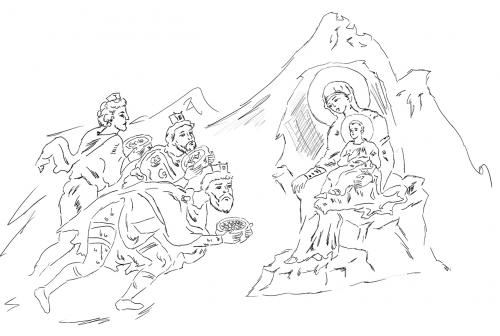



Închinarea magilor
În arta bizantină şi post-bizantină tema Închinării magilor apare adeseori inclusă în reprezentările Naşterii lui Iisus (vezi canonul „Naşterea lui Iisus”), dar poate fi reprezentată şi individual.
Ca temă individuală, are o structură simplă şi directă: pe fundalul peşterii, sau al ieslei, în ireprezentările influenţate de arta occidentală, Fecioara cu Pruncul în braţe este înfățișată aşezată, uşor întoarsă spre cei trei magi prezenţi în faţa sa, care i se închină şi îi prezintă daruri. În variantele mai complexe ale temei pot apărea şi personaje suplimentare, precum Sf. Iosif, îngeri sau alţi martori ai evenimentului.
Magii, al căror număr nu este specificat în Evanghelie, sunt reprezentaţi canonic în număr de trei, probabil după numărul darurilor pe care le-au oferit: aur, tămâie şi smirnă (Matei 2:9-11). Rangul, vârsta şi locul lor de origine fiind nespecificate în surse evanghelice, literatura apocrifă şi cea populară au fost libere să le atribuie cele mai diverse caracteristici multiplicând şi numărul lor până la 12, precum apostolii. Din această cauză, canonul picturii bizantine şi post-bizantine nu a stabilit un mod clar de reprezentare a magilor, limitându-le doar numărul la trei şi atribuindu-le doar un rang înalt - mag sau crai. Ei sunt văzuţi călărind spre peşteră, urmând lumina Stelei călăuzitoare, sau oferindu-şi darurile.
În arta bizantină şi post-bizantină tema Închinării magilor apare adeseori inclusă în reprezentările Naşterii lui Iisus (vezi canonul „Naşterea lui Iisus”), dar poate fi reprezentată şi individual.
Ca temă individuală, are o structură simplă şi directă: pe fundalul peşterii, sau al ieslei, în ireprezentările influenţate de arta occidentală, Fecioara cu Pruncul în braţe este înfățișată aşezată, uşor întoarsă spre cei trei magi prezenţi în faţa sa, care i se închină şi îi prezintă daruri. În variantele mai complexe ale temei pot apărea şi personaje suplimentare, precum Sf. Iosif, îngeri sau alţi martori ai evenimentului.
Magii, al căror număr nu este specificat în Evanghelie, sunt reprezentaţi canonic în număr de trei, probabil după numărul darurilor pe care le-au oferit: aur, tămâie şi smirnă (Matei 2:9-11). Rangul, vârsta şi locul lor de origine fiind nespecificate în surse evanghelice, literatura apocrifă şi cea populară au fost libere să le atribuie cele mai diverse caracteristici multiplicând şi numărul lor până la 12, precum apostolii. Din această cauză, canonul picturii bizantine şi post-bizantine nu a stabilit un mod clar de reprezentare a magilor, limitându-le doar numărul la trei şi atribuindu-le doar un rang înalt - mag sau crai. Ei sunt văzuţi călărind spre peşteră, urmând lumina Stelei călăuzitoare, sau oferindu-şi darurile.




